Rayman Origins hands-on preview
Four-player insanity erupts as we learn more about Rayman’s crazy dream world
Normally, when a bunch of jaded games journalists get together to preview an upcoming game, most of the noise in the room comes from the game itself. Within minutes of being let loose on the Gamescom demo of Rayman Origins, however, we heard something we hadn’t heard in years, at least not in a professional context: a lot of laughter and shouting, all of it coming from the supposedly world-weary writers at the controls. Clearly, this merited further investigation.
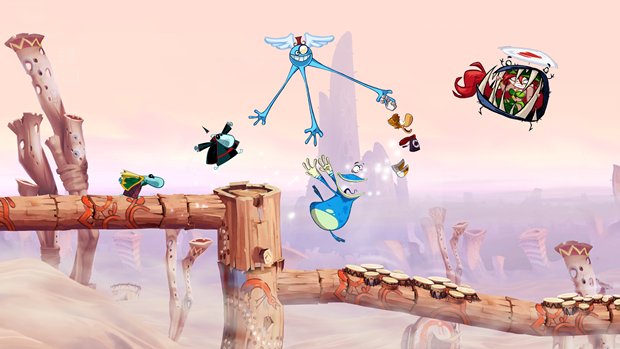
As it turns out, tackling Rayman Origins with four players is pure, unbridled chaos – think New Super Mario Bros. Wii, but with more abilities, and more things onscreen trying to kill you. As Rayman, his froglike friend Globox and two teensies (the crown-wearing Grand Minimus and the wizard-looking Dark Teensy, for those who care), players tear through beautiful, hand-painted worlds, leaping past obstacles and smacking monsters – and, more often than not, each other. You’ll normally want to cooperate with your friends, but there’s also a competitive aspect in the form of Lums, Origins’ glowing, ubiquitous, coin-like collectibles. Collecting the most in a given level gives you a higher score than your friends, and means you’ll “win” that level when you finish it.
Our time with Rayman was enormously fun, and opportunities to both help and grief our fellow players presented themselves constantly. The latter were often unintentional, though; as the action grows thick and the camera zooms out to take it all in, it can get extremely difficult to tell whether you’re the teensy accidentally smacking his teammate off a ledge, or the one plummeting to his doom.
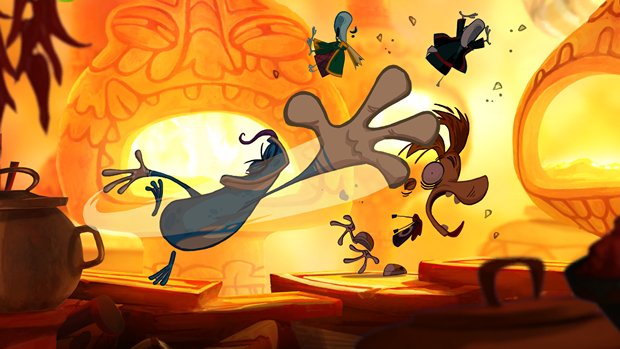
Fortunately, the confusion of having four players onscreen is offset by your teammates’ ability to resurrect you if you die. With more than one player, death means blowing up like a bubble and floating around freely until someone else tags you back in – again, like NSMBW. Unlike NSMBW, however, you’ll start farting out Lums if you’re a bubble for too long, meaning players who try to drift through tough spots stand to lose big (and jerk players stand to gain if they ignore their “dead” partners for a little while).Also, multiple players can occupy the same space, which comes in handy when everyone has to stand on the same tiny, floating platform.
If by this point you’re under the impression that Origins is a Mario knockoff with prettier visuals, then we’re doing the game a disservice. While the levels we played were immensely, chaotically fun, they were also surprisingly complex.
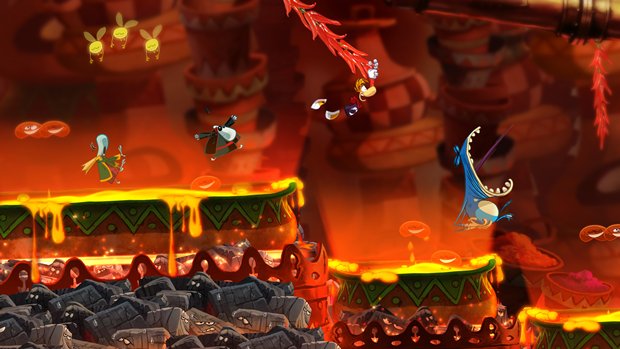
Like in the first Rayman, players earn new, permanentabilities as they progress through the game and meet fairies, who have to be freed from walking cages that don’t particularly want to be caught. The stages that we played through helped underline this; for example, in Frosty Delight (an ice-themed stage filled with giant hunks of fruit), we had the ability to slide down hills and – once we’d caught up with the fairy – to shrink when confronted with tight spaces and Rayman-shrinking devices.
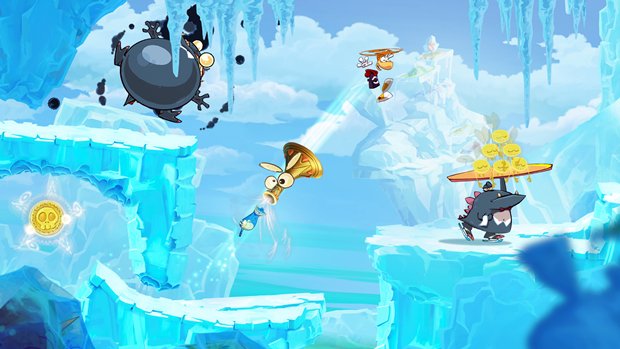
Above: Like this one, for example
Weekly digests, tales from the communities you love, and more
In another stage, set in the entrails of a dragon who’d swallowed the heroes, the ability to sprint up walls (and run on the ceiling, when the walls curve around just right) was essential, as we dodged lethal, rolling puffs of smoke and climbed rapidly through curvy intestines in an attempt to flee from an advancing wall of flaming indigestion. And in more than one stage, Rayman’s signature helicopter float (which the other characters imitate by flapping their arms) made all the difference between nailing a jump and winding up impaled on the spines of a floating pufferfish, or burnt in a giant pot full of lava. Even basic attacks are something that have to be unlocked (after the first stage, thankfully), and we wouldn’t have been able to beat the demo’s boss stage – titled Poor Little Daisy and starring the giant plant-monster from the E3 trailer – without it, as it required running into the thing’s mouth and giving a vulnerable bulb-thing a good smack.
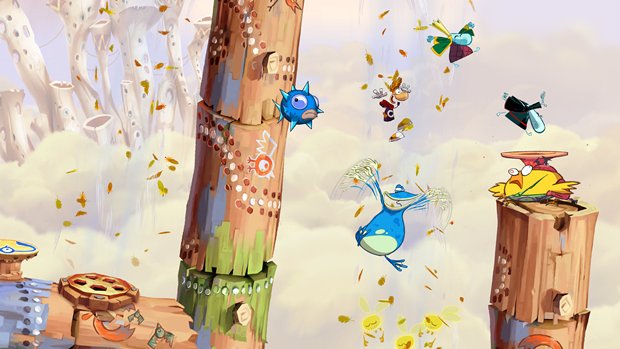
As you can probably guess (especially if you played the first Rayman), all these new abilities mean that a lot of stages feature areas you can’t access without skills found later in the game, giving players an incentive to go back and replay them. Interestingly, though, Origins takes this idea a step further; once you’ve earned all of the abilities, going back through the game will actually open up new levels in each area, which we’re told will be darker, tougher and feature entirely new bosses. Of course, you’ll need to beat these in order to actually finish the game.
It’s also worth pointing out that sometimes, players’ abilities and platforming talents won’t matter – like when Rayman and co. jump onto the backs of a huge-eyed mosquitos (or in Globox’s case, simply fly) and zip through 2D space-shooter stages, blasting enemies out of the sky and/or sucking them in to use as large projectiles. Other times, levels will introduce gameplay elements that complement your abilities, like a bat-filled cave that players have to navigate by smacking gongs, which then generate a protective shield just long enough for you to squeeze through unharmed.
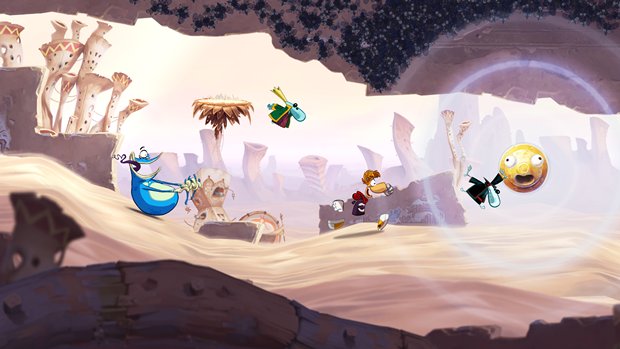
There are also a few collectibles to keep track of. In addition to the Lums, you’ll hunt for Electoons, little pink creatures locked away in semi-hidden (and often hard-to-access) cages. These cages have to be punched a few times before they’ll open, and they’re often guarded by monsters like the floating, batlike Cyclops, which creates a dark shield around cages and has to be smacked down before said cages become unlockable.
However, the real collectibles to keep an eye out for are the skull coins, which grant access to “chest chase” levels. Designed to be a hell of a lot harder than “normal” levels (which is saying something, as the ones we played were pretty difficult to begin with), these task players with keeping up with a fleeing chest as it impudently tears ass through obstacles and enemies, scrolling the screen along with it. The one chest-chase level we played – set in a windy desert with lots of pitfalls and spiky things – was tough almost to the point of unfairness, killing all four players more often than any other stage we tried.
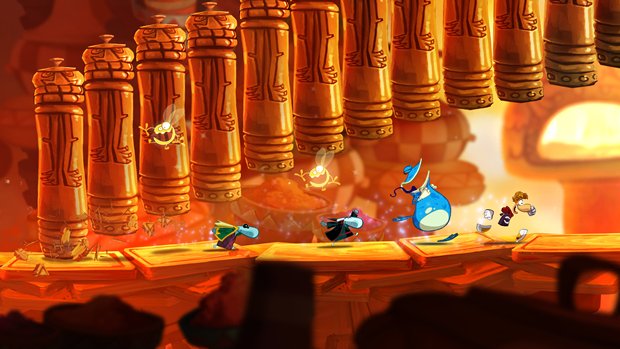
Finding all the chests, however, is the key to entering the game’s final stage, the Land of the Livid Dead, where all your enemies come from – and on that note, we also learned a bit about Origins’ story, to which this trailer is a good introduction:
In an attempt to bring a “global coherence” to Rayman’s story, Origins brings it back to… well, to its origins. More specifically, it brings it back to Polokus the Bubble Dreamer, a supreme being who dreamed Rayman’s world into existence, and who now hangs out in Rayman’s hollow-tree house, idly blowing bubbles while Rayman tries to rid the world of his nightmares, which apparently emanate from the Land of the Livid Dead.
Freeing Electoons will gradually restore the Bubble Dreamer’s memories, which in turn will prompt him to tell goofy stories about the world’s characters when Rayman visits his house between levels. These stories are more than just plot, however, as they’ll apparently unlock those characters and make them selectable. We’re told there will be between 10 and 20 different characters in all, although these will reportedly be variants on the same three themes, including four Rayman variants (including Dark Rayman from the first game), four Globoxes (including a red version of Globox,which was apparently his original color before eating a poison berry) and an undetermined number of teensies.

The Bubble Dreamer isn’t just Rayman’s personal deity, either – he’s worshipped by creatures throughout the world he created, including a sect of fakirs who want him to grow up and be a little more serious. (However, given that they worship him by sacrificing peas, their idea of “serious” might be a little different than ours.) In a level we saw but weren’t able to play, these ascetics were tormented by Rayman and friends, who jumped on their broad hats and swung from their beards as they raced through what we’re assuming is some kind of monastery.
In spite of the chaos of playing with a full set of players (two, three or even solo play proved a little more tolerable), our time with Rayman Origins was enormously, captivatingly fun. Even going by the five levels we played, the game already looks to have an enormous amount of variety (and more than enough balls-hard challenges for hardened old-schoolers), with a wildly inventive aesthetic and entertainingly goofy, breathtakingly pretty visuals. Whether that’ll be enough to convince picky gamers to fork over $60 when it ships in the middle of busy November remains to be seen, but we’re certainly excited to see more.
Aug 17, 2011



